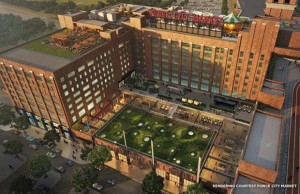 Many business owners might assume that building out networks in large commercial buildings would be easy. After all, these large structures often have considerable “dead space” in walls and ceilings that can be leveraged for running cables. In addition, wide, open spaces present a blank palette, right?
Many business owners might assume that building out networks in large commercial buildings would be easy. After all, these large structures often have considerable “dead space” in walls and ceilings that can be leveraged for running cables. In addition, wide, open spaces present a blank palette, right?
In reality, nothing could be further from the truth. Large commercial buildings—especially existing “historic” buildings—present special challenges that can complicate network design and buildout.
A prime example was a project LMI completed at the historic Sears Building (now part of Ponce City Market) in East Atlanta. An organization that had leased office space in the building wanted an entirely open architecture that utilized the wide, open spaces left from the former retail use of the structure. Consequently, traditional solutions—such as running cable to the base plates of the office furniture— weren’t an option.
During the planning phase, LMI network experts identified large structural poles, dispersed across the floor space, that supported the open expanses within the building. After investigating the pole design, LMI engineers determined they could leverage these columns for cable drops, creating “satellite” connectivity stations around which desks and offices could be arranged.
This is just one example of the creativity that large, historic buildings—and for that matter, all commercial buildings with large, unbroken areas—may require. By the end of this project, LMI had run cable drops for 60 end-user locations inside 15 structural poles—and installed more than 320,000 feet of Ethernet and fiber optic cabling across and through the ceiling.
Running such a large amount of cable required creativity in other areas, such as the use of state-of-the-art cable management systems to organize the cabling in the ceiling. Cables were also color tagged by type to facilitate troubleshooting and replacement—but the colors were changed from traditional dark colors to light ones so the tags would not be visible through the translucent ceiling.
The project was a success, and LMI was honored to have been part of the adaptive reuse of such an important historic structure. For this and all of our networking projects, we rely on top-notch products and advice from a stable of respected cabling and cable management equipment vendors, including Belden, Ortronics and Superior Essex. Other leading networking component and infrastructure providers with which we work include Aerohive Networks, Aruba Networks, Fluidmesh Networks and SonicWall.
